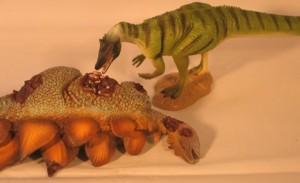Planet Dinosaur – Episode Four “Fight For Life”
A Review of Planet Dinosaur – Episode 4 “Fight for Life”
Having bemoaned the absence of any Triassic dinosaurs in this excellent television series, it was a pleasure to see the warm, shallow seas of the Jurassic featured in this episode of “Planet Dinosaur”. The focus on this particular programme was the predator/prey relationship, a rich hunting ground for the production team given the amount of fossil evidence that can be interpreted to show such affinities. The fossil record and the various pathologies of body fossils, coupled with an examination of the natural world today and predator/prey relationships provides plenty of material. The marine predator featured was the huge pliosaur “predator X”, with its rosette of 30 centimetre long teeth. The prey was the plesiosaur – Kimmerosaurus langhami, one of our favourite plesiosaurs, anything named after the Kimmeridgian faunal stage is fine by us. This part of the programmes showed these long-necked beasts, ploughing through soft mud in search of shell fish, worms and other food items. The fossil evidence for this behaviour comes from a cliff face in Switzerland which has a number of long, weird grooves preserved in the rock, which was once sediment at the bottom of a shallow, tropical sea. Scientists believe these grooves were dug out by plesiosaurs as they swam along with their snouts in the sediment searching for food. They could also have been created as these marine reptiles searched for stones to swallow to act as ballast and as gastroliths to help them grind up food. We noted that Dr Adam Smith (plesiosaur expert) was named in the credits.
A Museum Exhibit of a Giant Pliosaur

The life-size replica of the pliosaur (P. carpenteri) suspended from the ceiling at the Bristol Museum and Art Gallery. Pliosaurus carpenteri was formally named and described in 203 (Benson et al). Picture credit: Everything Dinosaur.
Picture credit: Everything Dinosaur
Planet Dinosaur
The terrestrial part of the programme took viewers to the Morrison Formation of the western United States. It discussed the relationship between Allosaurus and two prey genera – Camptosaurus and Stegosaurus. The programme postulated that Camptosaurus and Stegosaurus lived together for mutual benefit. The Camptosaurus with their bipedal stance acting as look outs for the heavily armoured stegosaurs. Such relationships are seen in nature today, for example, in Africa our team members have observed Ostriches and Zebra feeding together. The Zebras rely on the Ostrich with their heads held high and superb eyesight to spot danger. Whether or not Camptosaurus and Stegosaurus actually sought out each other for mutual protection is a little speculative, but certainly feasible, if difficult to prove given the fossil record. Allosaurus fragilis was the hunter, an interesting interpretation, especially the colouration and the crests above the eyes – they reminded us of sun-shades, these would have been useful especially if this predator was most active at dawn or dusk, with the sun low in the sky, just like many predators today. Surprisingly, Saurophaganax got a look in, S. maximus a very large allosaurid which was first studied in the 1930s. We thought that this theropod had been re-classified as just a very big A. fragilis, but no, there it was in all its glory, bullying the Allosaurus out of its kill, its twelve metre-length making it about 15% bigger than the other theropod.
Interestingly, Saurophaganax is not featured or even mentioned in the book that accompanies this BBC television series.
Models of a Saurophaganax and a Stegosaurus Corpse (CollectA)

Food for a dinosaur? A replica of a Saurophaganax inspects a Stegosaurus carcass. Both models are from the CollectA Age of Dinosaurs/Prehistoric Life model series.
Picture credit: Everything Dinosaur
To view the range of CollectA Age of Dinosaurs/Prehistoric Life models available from Everything Dinosaur: Jurassic Dinosaur Models (CollectA Prehistoric Life).

